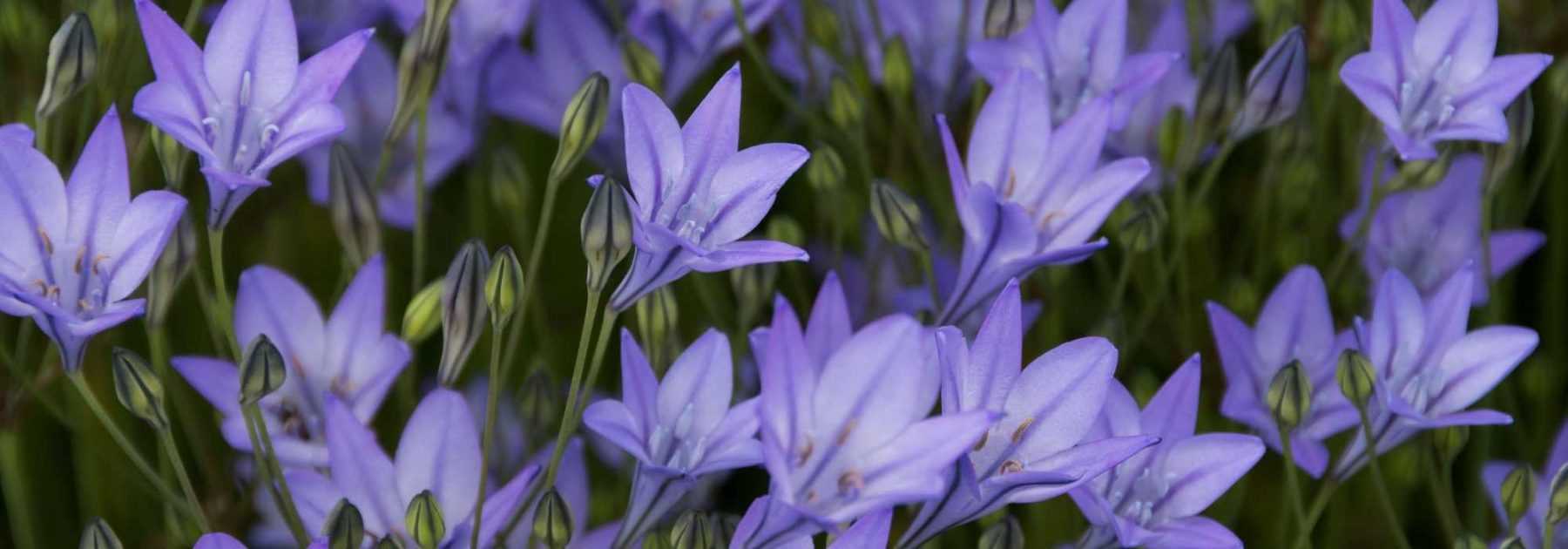
Triteleia - Brodiaea: Planting, Growing and Caring for Your Young Plants
Contents
Triteleias in a few words
- Triteleias produce star-shaped flowers during summer
- Triteleia flowers come in blue, white, pink or yellow
- These are corm plants, a type of bulb
- Triteleias love sunny spots and very well-drained, stony or sandy soil
- Plant Triteleias in rock gardens, dry gardens or even containers
Our expert's word
Triteleias (or Brodiaea) produce stunning star-shaped flowers. The effect is fabulous, especially when planted en masse. It’s then a cloud of blue, white or pink stars depending on the variety that unfolds before you between June and August. Come autumn, the plant disappears completely underground, only to reappear the following spring. Beware of untimely spade work if you’ve forgotten where they are!
We often think of Triteleia laxa, the species type and its many derived varieties, with more or less blue tones and sometimes double flowers like Triteleia ‘Aquarius’. However, let’s not forget Triteleia ixoides with its cream-yellow flowers striped with dark brown. A marvel!
Triteleias thrive in full sun, or partial shade in the southern part of the country, within a rockery or dry garden.
Be warned – if, like mine, your soil is dreadfully heavy and wet, you’ll need to plant them in sand (yes, literally!) or, more simply, keep them in pots. Otherwise, they won’t last long… Triteleias detest winter moisture!
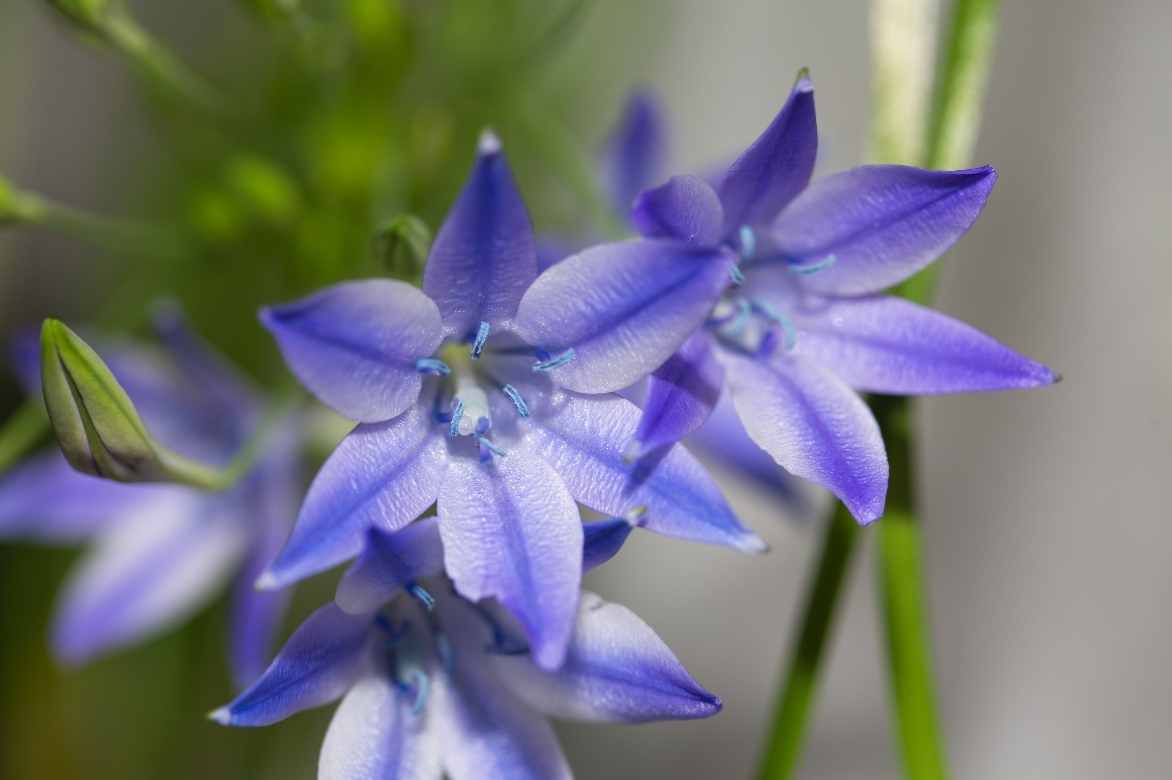
Triteleia laxa
Botany and description
Botanical data
- Latin name Triteleia sp. (or Brodiae sp.)
- Family Asparagaceae
- Common name Triteleia (sometimes Brodiaea)
- Flowering May to August
- Height 25 to 45 cm
- Exposure sun or partial shade
- Soil type very well-drained, stony or sandy
- Hardiness -10° C
Triteleias are bulbous plants from the Asparagaceae family (according to the latest phylogenetic classification) and the Brodiaeoid subfamily. In fact, it’s not uncommon to still encounter the genus name Brodiaea instead of Triteleia in literature or commerce. Beware of confusion!
The genus name Triteleia comes from Greek: from “Treis” (three) and “Teleios” (perfect), referring to the flower’s regular star shape. In California, Triteleia laxa is nicknamed “Ithuriel’s Spear”, one of the angels in “Paradise Lost”, a poem by John Milton (1667).
The different species of Triteleia are native to dry prairies and woodlands of the western United States.
The Triteleia genus includes about twenty species, the most well-known and cultivated being Triteleia laxa.
To be precise, triteleias are actually cormous plants. Corms are swollen underground stem parts that serve as nutrient storage organs, resembling bulbs. This is why triteleias are classified as “bulbous” plants.
The deciduous foliage appears in spring, forming a clump of lanceolate leaves, slender, 20 to 30 cm long and green in colour. The leaves lie down and turn yellow, or even dry out, as flowering begins. The plant completely disappears after flowering.
Flowering begins in May for Triteliea laxa and Triteleia ixoides, continuing until August for some varieties like Triteleia ‘Rudy’ or Triteleia ‘Queen Fabiola’. Each corm produces large umbels of about twenty blue, white (Triteleia ‘Silver Queen’), pink or even yellow flowers (in Triteleia ixoides). The tubular flowers open into star shapes and are borne on slender, rigid stems up to 50 cm tall. The flowers can be used in bouquets.
If conditions suit them, Triteleias naturalise easily, forming beautiful colonies over the years. Triteleias are grown in rock gardens, dry gardens and even in containers.
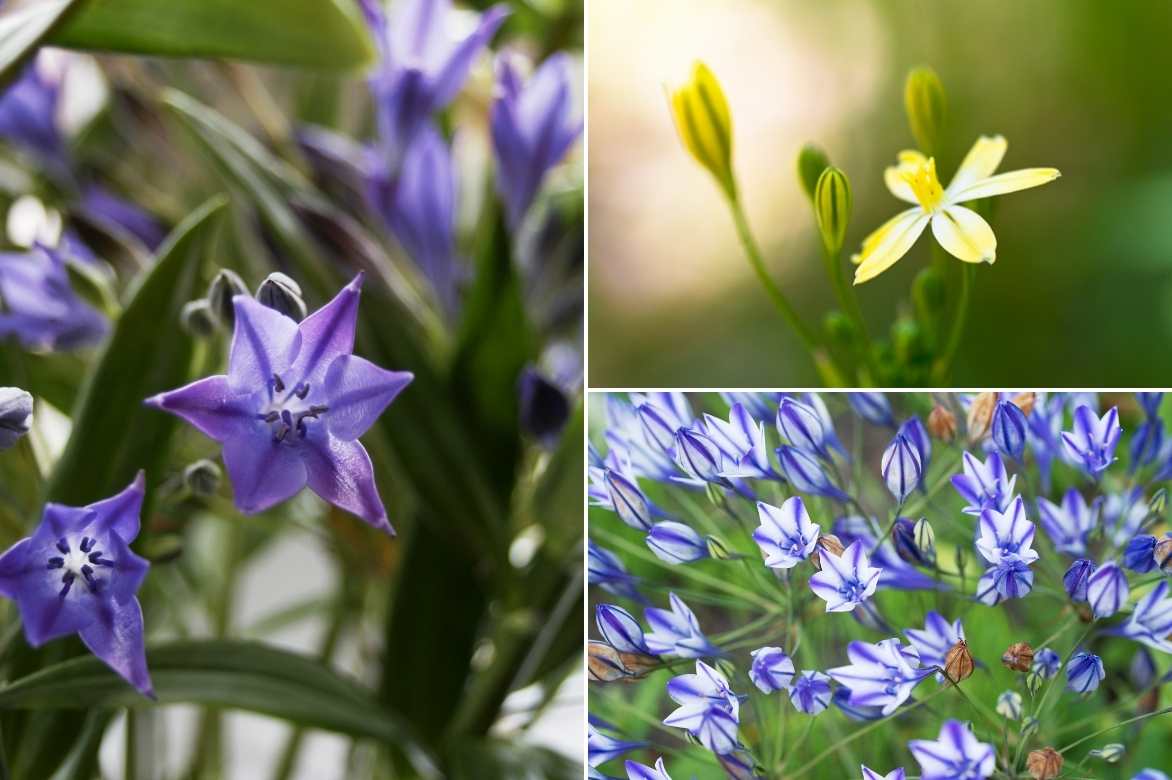
Blue Triteleias laxa, with Triteleia ixioides at top right
Read also
Planting summer-flowering bulbsOur most beautiful varieties
[product sku=”51966″ blog_description=”Triteleia laxa is a lesser-known bulbous plant, producing remarkable small star-shaped flowers with bold purple-blue stripes.” template=”listing1″ /]
[product sku=”1173″ blog_description=”Triteleia laxa ‘Queen Fabiola’ is one of the most hardy varieties. It blooms into a cloud of small sky-blue flowers striped with navy blue.” template=”listing1″ /]
[product sku=”1175″ blog_description=”Triteleia ‘Rudy’ produces, in early summer, a cloud of small star-shaped white flowers with dark blue markings.” template=”listing1″ /]
[product sku=”15575″ blog_description=”Triteleia laxa ‘Silver Queen’ is an exceptionally refined and luminous variety, with white iridescent flowers displaying a lovely silvery sheen.” template=”listing1″ /]
[product sku=”1174″ blog_description=”Triteleia ‘Corinna’ produces, in early summer, a cloud of small star-shaped flowers in a deep violet-blue hue.” template=”listing1″ /]
[product sku=”83752″ blog_description=”Triteleia ‘Aquarius’ blooms into a multitude of small, very double and intensely blue flowers, edged with midnight blue on the reverse.” template=”listing1″ /]
[product sku=”1176″ blog_description=”Triteleia ixioides ‘Starlight’ is the only variety in the genus to bear creamy yellow flowers. Earlier than others, it blooms as early as May.” template=”listing1″ /]
Discover other Triteleia
View all →Available in 1 sizes
Available in 1 sizes
Available in 1 sizes
Available in 1 sizes
Available in 1 sizes
Available in 1 sizes
Available in 1 sizes
Available in 1 sizes
Planting Triteleias
Where to plant?
Triteleias should be planted in full sun, or partial shade in the southern part of France. In cooler climates, remember to plant your triteleias well protected from cold and wind: near a south-facing wall for example.
The soil should be fertile, but above all light and well-drained. The ground must remain moist during the growing season, but dry during the dormant period in winter. Planting Triteleia corms directly in sand greatly improves the plant’s hardiness.
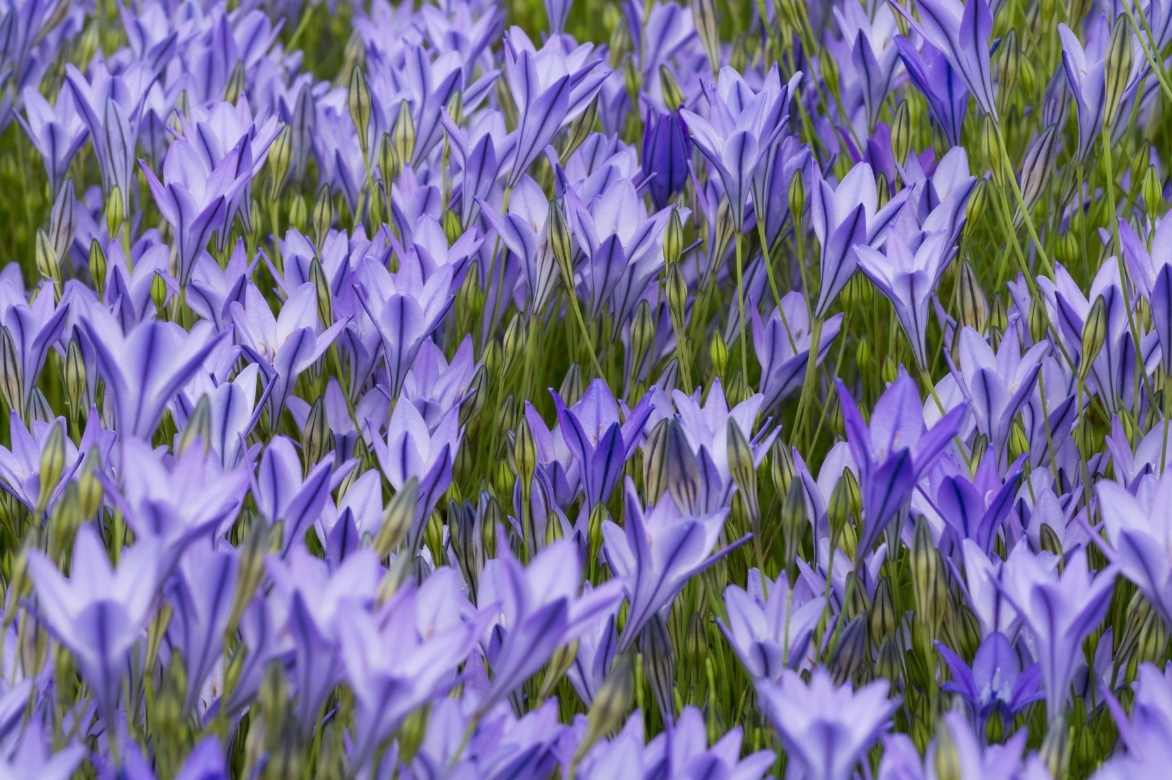
Triteleias look stunning when planted en masse
When to plant
Triteleias can be planted in autumn (in October), but spring is the best time: planting should preferably be done between March and April.
How to plant?
In the ground:
- Loosen the soil to a depth of about ten centimetres;
- Add well-rotted compost, sand or even some gravel to lighten the soil and improve drainage;
- Plant your corms (bulbs) 10 cm deep at a rate of 20 corms/m²;
- Cover with mulch in winter to protect the corms from severe frosts.
In pots
- Choose a terracotta pot, with drainage holes at the bottom;
- Fill it with a light substrate such as Mediterranean plant compost;
- Plant your corms (bulbs) 10 cm deep;
- Potted triteleias are more vulnerable to cold than those in the ground: only place the pot outside when all risk of frost has passed.
Maintenance
Maintenance is limited to watering during the growing season (when foliage appears) and only if the soil is dry. In pots, water every two days, always during the growing season.
During the dormancy phase, when the plant appears to have disappeared, the soil or substrate must remain dry.
If your triteleias are grown in pots, bring them into a frost-free location during winter.
Note: during dormancy, when triteleias have completely disappeared underground, there is a risk of damaging the corms with tools. Remember to place markers to avoid this.
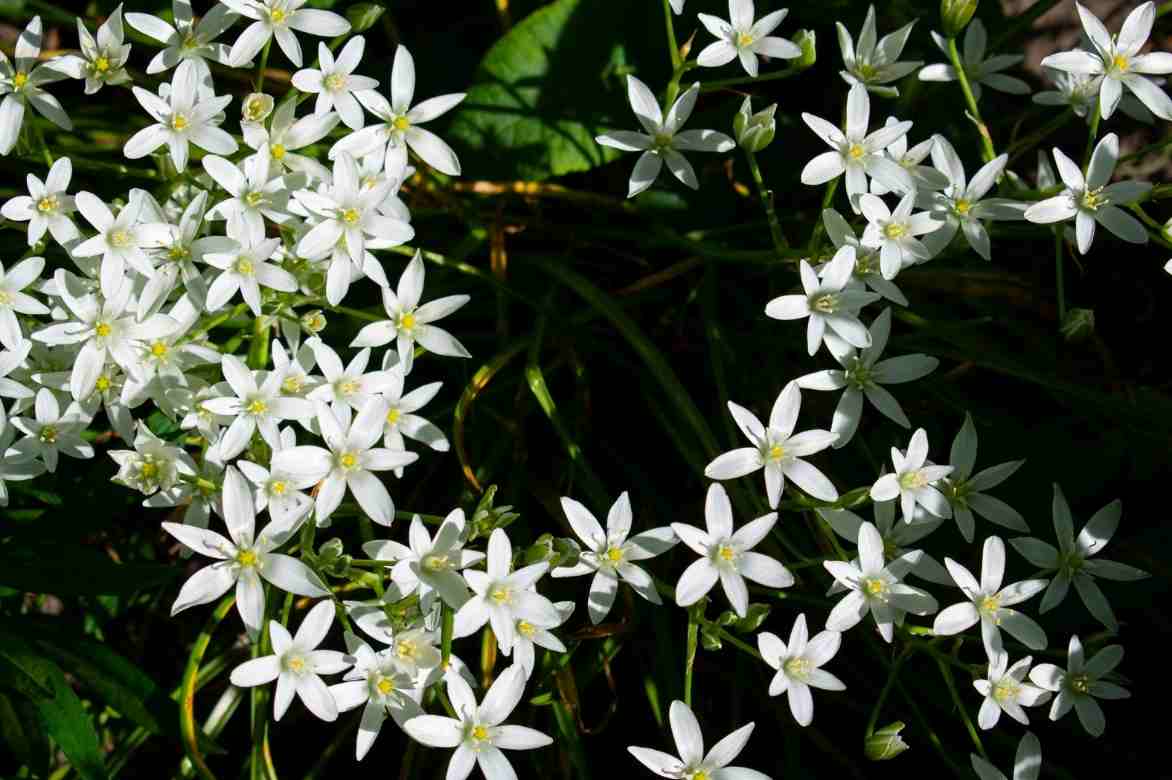
Triteleia uniflora
Diseases and Pests
Triteleias are not affected by any diseases or pests. The only thing they fear is winter moisture.
Propagation
By sowing
It is possible, though very time-consuming, to propagate your triteleias by sowing. Simply collect the ripe seeds in summer and sow them in a well-draining substrate (half sowing compost and half river sand) at a temperature around 15°C.
The first flowers will only appear after 4 years of cultivation. Impatient gardeners, beware!
Or more quickly and easily…
Small corms develop around the planted triteleia corms. You can either leave them undisturbed to allow a tapetum of triteleias to form, or dig slightly at the spot to retrieve the small corms and relocate them elsewhere in spring.
Association
The issue with Triteleias is that their foliage becomes unsightly during flowering. We should therefore aim to conceal it with low-growing plants. However, these companion plants must thrive under the same growing conditions as our Triteleias: full sun, very well-drained soil, yet moist in summer.
Why not mix different Triteleias? Blue, yellow, and white ones striate with blue. For instance, single Triteleia laxa (type species) with violet-blue flowers, Triteleia ‘Rudy’ with strikingly original blue and white flowers, and Triteleia ixioides ‘Starlight’ with creamy-yellow flowers that will contrast beautifully with the cool tones of the other two.
To complement them, let’s stick to blue and yellow hues with a few other perennials. Yellow-green foliage and blue flowers can be achieved with one or two Gentiana cruciata—somewhat finicky but also favouring well-drained, moist soil during flowering. For more blue flowers, consider Amsonia ‘Blue Ice’, whose star-shaped blue flowers will echo those of the Triteleias. Carex oshimensis ‘Evergold’ is a reliable choice, enhancing the blue blooms with its green foliage and broad cream stripe. Finally, a yellow-flowering groundcover like Helianthemum ‘Ben Fhada’ will serve as a perfect frame for the Triteleias’ flowers.
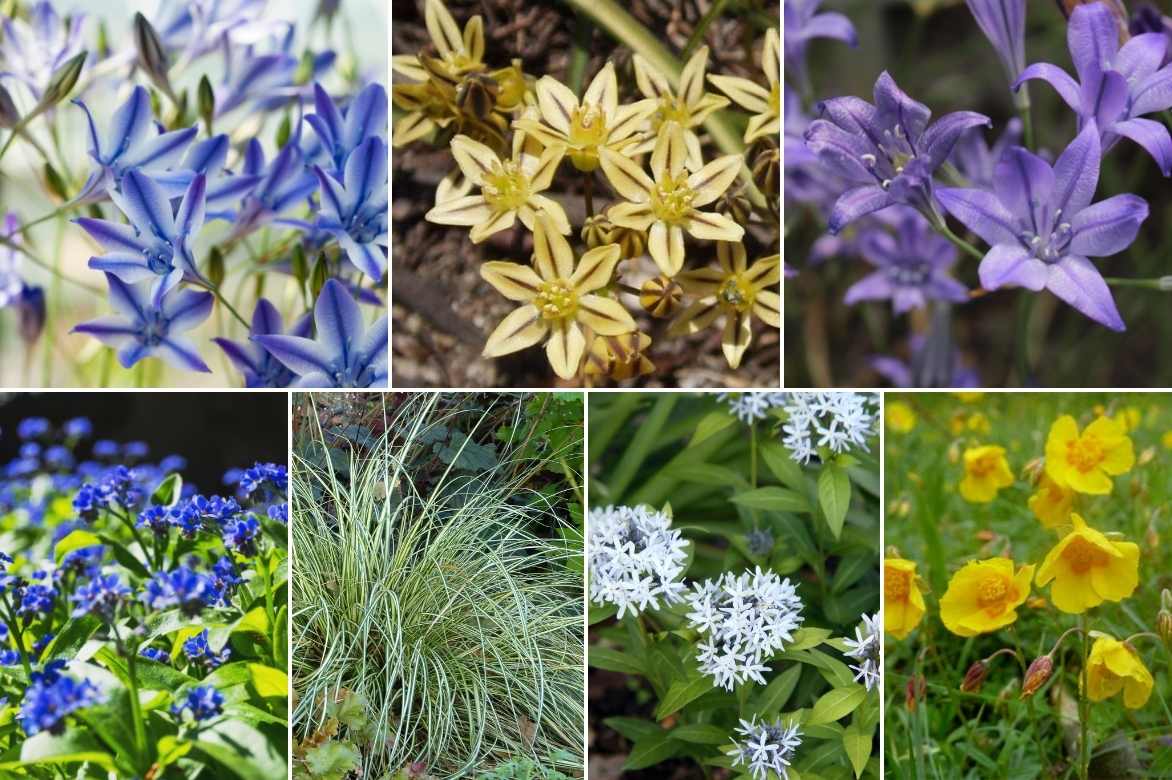
Triteleia ‘Rudy’, Triteleia ‘Starlight’, and Triteleia laxa beautifully paired with Gentiana cruciata, Carex oshimensis ‘Evergold’, Amsonia ‘Blue Ice’, and Helianthemum ‘Ben Fhada’
Useful resources
- Find our triteleias in our online nursery.
- Discover how to pair triteleias.
- Subscribe!
- Contents


































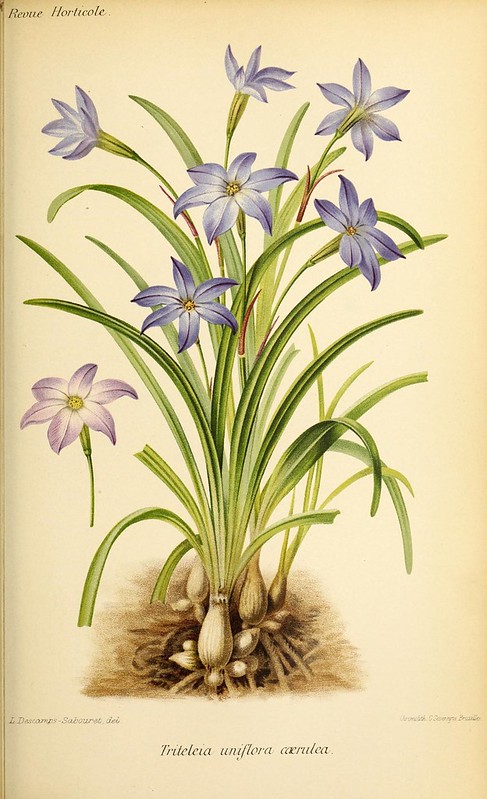
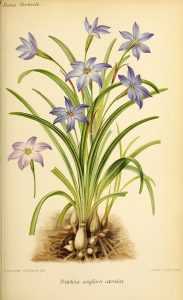
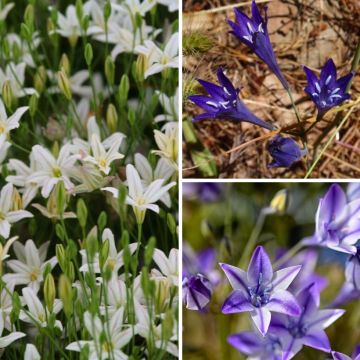
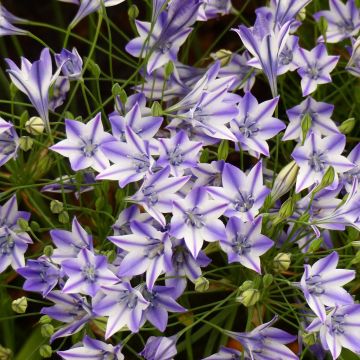
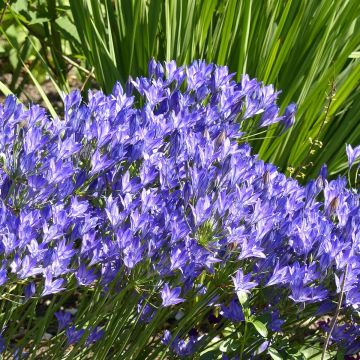
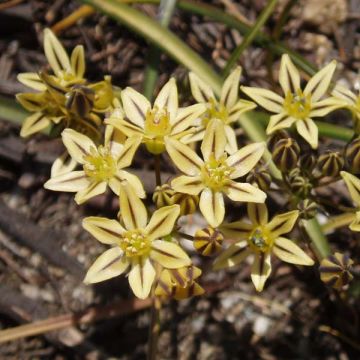
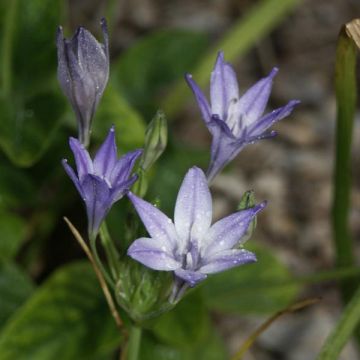
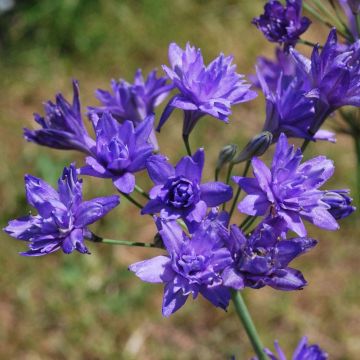
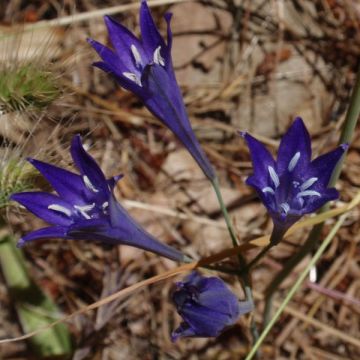
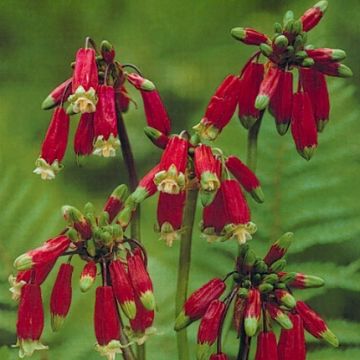
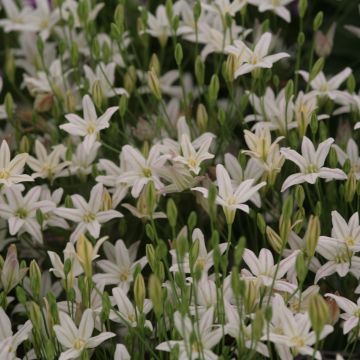
Comments